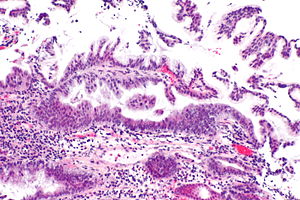Foveolar type dysplasia
Jump to navigation
Jump to search
Foveolar type dysplasia, also foveolar dysplasia, is a form of dysplasia that arises from the foveolar cells, typically seen in the stomach. It may be subtle to unaccustomed eyes.
| Foveolar type dysplasia | |
|---|---|
| Diagnosis in short | |
 Foveolar dysplasia of the duodenum. H&E stain. | |
|
| |
| Synonyms | type 2 dysplasia, foveolar dysplasia, foveolar/hyperplastic dysplasia |
| LM DDx | benign foveolar epithelium, gastric heterotopia (if not stomach), benign ampullary epithelium, hyperplastic polyp |
| Site | stomach, duodenum (esp. ampulla of Vater), esophagus |
|
| |
| Syndromes | familial adenomatous polyposis |
|
| |
| Prevalence | not common |
| Other | may be subtle |
It is also described as non-adenomatous dysplasia, type 2 dysplasia and foveolar/hyperplastic type dysplasia.[1]
General
- Precursor to adenocarcinoma.
Microscopic
Features:
- Tall columnar cells with basal nuclei in a villiform architecture.[1]
DDx:
- Benign foveolar epithelium - seen in stomach and ampulla of Vater.
- Gastric heterotopia.
- Hyperplastic polyp.
Images
www: